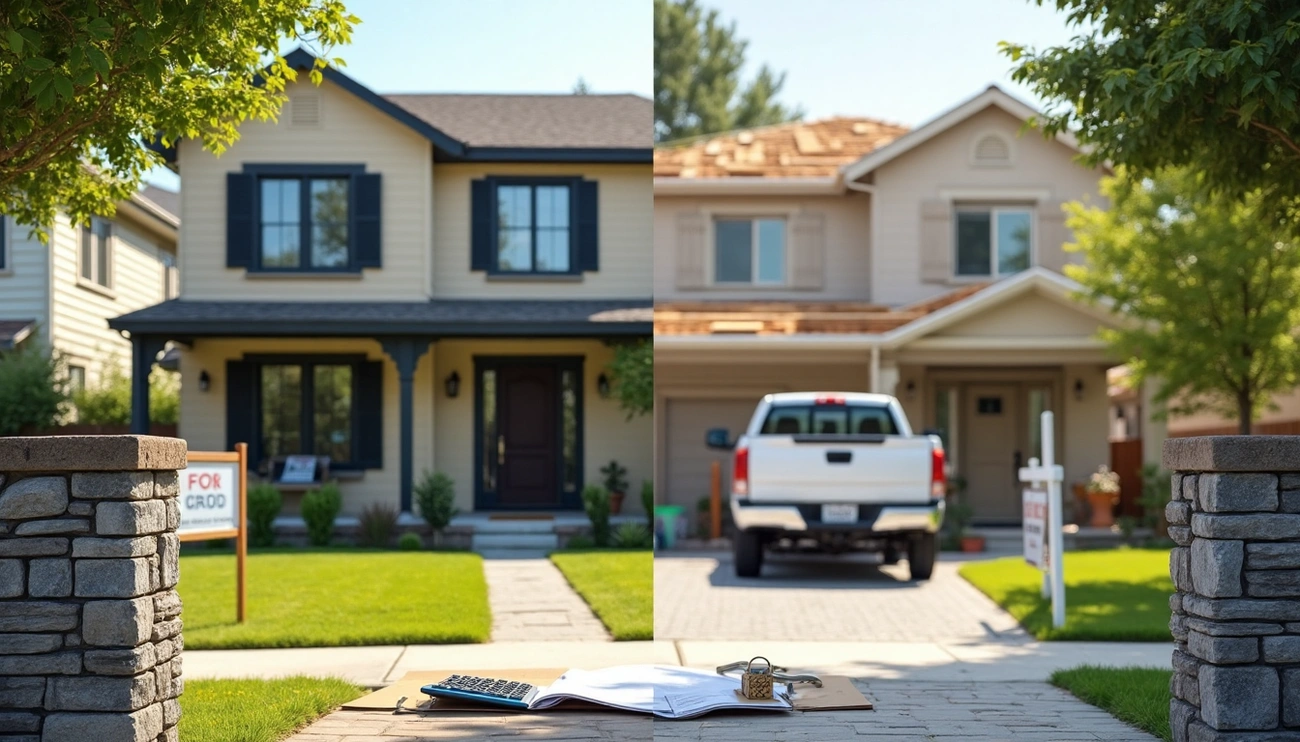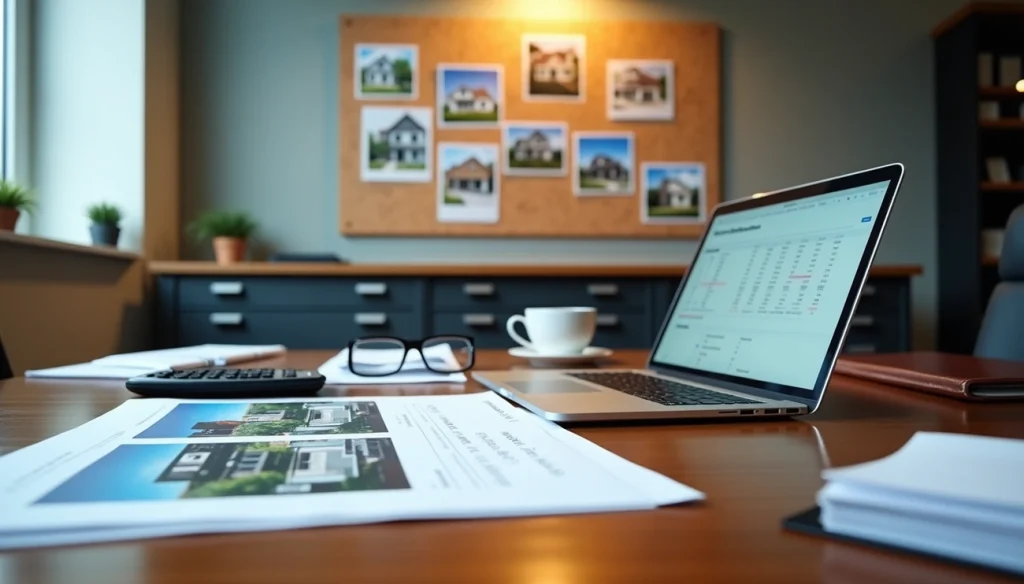Real estate investing through buy and hold strategies creates substantial wealth-building opportunities. Rental properties generate steady income that bounces back even after market downturns. The choice between investment strategies becomes crucial at the time you decide between steady buy and hold or quick house flipping that takes about six months to complete.
House flipping across the country yields a 25% profit margin with roughly $62,000 gross profit, though returns differ by location. Buffalo, NY’s market showed an exceptional 121.7% return on investment, while buy and hold properties come with their own advantages. Your benefits as a long-term real estate investor include decreasing mortgage balances, property value growth potential, and tax-deductible mortgage interest that creates financial advantages. Rental rates rise with inflation, which makes buy and hold properties an effective hedge against it.
Each strategy works well based on your financial objectives and available time. Recent data shows flipping made up 7.5% of all home sales in 2022’s third quarter, indicating strong interest in short-term investments despite a quarterly drop. Long-term property ownership helps stabilize communities by offering steady rental housing options and passive income streams. The market conditions in 2025 raise an important question – which approach will build more wealth for your portfolio?
Buy and Hold vs Flipping: Core Strategy Differences
The biggest difference in real estate investment strategies comes from how they make returns. Learning about these differences helps you pick a strategy that lines up with your financial goals, risk comfort level, and personal priorities.
Buy and Hold: Long-term rental income and appreciation
Buy and hold real estate is a long-term investment path where you buy properties to own them over extended periods—usually 5 to 30 years. This approach builds wealth in two ways: steady rental income and property value growth over time.
The heart of buy and hold investing focuses on getting quality properties that bring in stable yearly returns while building equity. This strategy wants to create passive income—money that keeps flowing whatever your daily involvement. Your tenants pay down your mortgage, which builds up your equity position every month.
Buy and hold investors usually utilize moderate financing, with debt around 30-50% loan-to-value ratio, which creates a lower-risk investment profile. These investments typically bring returns between 5-8% net equity IRR. You also get extra benefits through tax advantages and property appreciation.
Fix and Flip: Short-term renovation and resale for profit
Fix and flip works differently. You buy properties below market value, improve them through smart renovations, and sell quickly to make a profit. A typical house flip takes 6-8 months from purchase to sale. Experienced investors might complete projects in just 3-6 months.
Fix and flip creates active rather than passive income. It works more like running a business than making a traditional investment. Success in flipping depends on finding properties at bargain prices—either distressed sales or homes that need major work. Your profit comes from adding value through renovations and selling fast at the improved price.
Flipping can bring big short-term returns, with possible profits of 25-30% per project. These higher returns come with bigger risks. You might face renovation cost overruns, market changes during ownership, and higher taxes since profits usually count as ordinary income instead of capital gains.
Time horizon and investor involvement
These strategies need very different time commitments. Buy and hold investing needs less daily management but requires patience and a long-term outlook. Property management duties exist—from screening tenants to fixing issues—but many investors let professional management companies handle these tasks.
Flipping needs much more hands-on work during renovations. Even with contractors doing the work, you’ll spend lots of time managing the project. You must make quick decisions when issues come up and watch market conditions closely to ensure a profitable sale.
Your time, skills, and money should guide your strategy choice. Flipping might suit you if you enjoy managing projects and know construction. Buy and hold could work better if you want steady returns without intense time demands.
Some investors do well with a mixed approach. They use profits from successful flips to fund long-term buy and hold purchases, mixing quick gains with lasting wealth building.
Learn which strategy fits your situation and goals best. Schedule a strategy call with Primior’s real estate investment experts at https://primior.com/start/.
Pros and Cons of Buy and Hold Real Estate Investing
The long-term investment approach in real estate offers several compelling advantages and important considerations for potential investors. You can make informed decisions about buy and hold real estate investing by understanding these factors and how they line up with your wealth-building goals.
Cash Flow and Passive Income Potential
Buy and hold properties create reliable income streams through regular rental payments. Proper tenant screening and management help this income provide consistent cash flow for mortgage payments, property taxes, insurance, and maintenance costs. The rental income alone produces 4% to 10% return on investment, depending on market location. This ongoing revenue creates financial stability and adds to other income sources.
Some people call it passive income, but rental properties need some involvement. As one investor notes, “Some may call this passive income, but it is anything but passive. Ask anyone who has had to deal with tenants”. Notwithstanding that, you can minimize your personal involvement by hiring property management companies to handle day-to-day operations, which makes it more passive over time.
Appreciation and Equity Growth Over Time
Property appreciation drives wealth creation in buy and hold investing. According to real estate experts, “As population increases, the demand for real estate rises, and well-located properties become more valuable”. This appreciation represents your property’s increasing desirability to potential buyers.
Your property’s equity and appreciation create a compounding effect together. You build equity as you pay down your mortgage. The property’s rising value increases your equity position at the same time. These two factors speed up wealth accumulation over the long term. Properties in high-demand areas tend to appreciate faster, which accelerates equity growth.
Tax Benefits: Depreciation and Long-Term Capital Gains
Buy and hold real estate’s tax advantages substantially contribute to overall returns. The IRS allows depreciation deductions over 27.5 years for residential properties, while commercial properties can be depreciated over 39 years. This non-cash deduction reduces taxable income without extra spending.
You can deduct these expenses:
- Mortgage interest and property taxes
- Operating expenses and repairs
- Property management fees and travel expenses
- Insurance premiums and utilities
Profits get taxed at favorable long-term capital gains rates when you sell after holding for more than a year, rather than as ordinary income. Many taxpayers pay a 15% federal tax rate instead of higher ordinary income rates.
Risks: Vacancies, Maintenance, and Management Burden
Buy and hold investing presents some challenges despite its advantages. Vacant rental properties pose one of the biggest risks—you must cover mortgage payments without rental income during vacancies. Smart investors maintain reserves for 1-3 months of expenses to handle vacancy periods.
Problem tenants can damage property, miss rental payments, and create legal issues. Unexpected maintenance costs and repairs can eat into profits without proper budgeting. Experienced investors say poor property management can “increase vacancy losses, result in excessive maintenance costs, and ultimately, reduce the property value”.
Buy and hold real estate needs patience and planning. Your investment’s success depends on property location, market demand, and effective management strategies. You can schedule a strategy call with Primior to get personalized guidance on implementing this strategy: https://primior.com/start/
Pros and Cons of Flipping Real Estate
House flipping creates a unique path to real estate wealth when compared to buy and hold strategies. Property flippers earned median profits of about $73,500 per property in 2024. This strategy appeals to investors who want faster returns on their money.
Quick Profit Potential and Capital Liquidity
House flipping brings faster financial returns than long-term investments. Most flips take about six months to complete. New investors should plan for longer timelines. The strategy helps minimize the time your capital stays tied up. A successful flip lets you recover your investment plus profit quickly. You can then put that money into new projects. The return on investment can be high—averaging 30%, down from 50% a decade ago.
Market Timing and Renovation ROI
Market timing makes or breaks a flip’s success. Real estate markets move slower than stock markets. This gives strategic investors a more predictable environment to work in. Market changes during renovations can affect your profits. You need to learn about local housing trends, buyer priorities, and property values before starting a project.
High Capital Requirements and Tax Implications
House flipping needs big money upfront. You must cover buying costs, renovations, and ongoing expenses like mortgage payments, utilities, property taxes, and insurance. The profits get taxed as short-term capital gains at your regular income tax rate. Long-term capital gains have lower rates. This tax difference can cut into your net profits compared to buy and hold strategies.
Operational Risks and Time Commitment
Real-life house flipping differs from what you see on TV. Each day a property remains unsold adds holding costs that eat into profits. Renovation projects often hit snags—hidden structural problems, permit holdups, or contractor delays can stretch timelines and increase costs. Even with contractors doing the physical work, you must spend time managing projects, handling inspections, and meeting code requirements.
A personal consultation helps investors pick the real estate strategy that matches their goals and skills. Schedule a strategy call with Primior’s real estate investment experts: https://primior.com/start/
Financial Considerations: Capital, Taxes, and Returns
Real estate investment strategies show key differences in how much money you need, what taxes you’ll pay, and how you’ll earn returns. These differences will shape your path to building wealth, whatever strategy you choose.
Initial Investment: Down Payment vs Rehab Costs
Buy and hold strategies need down payments of 15-25% for investment properties. Most investors must put down at least 20% when buying investment properties. Those with credit scores above 680 might qualify for down payments as low as 15%. House flipping needs money upfront for both buying and fixing up properties. Hard money rehab loans can help fund these projects. These loans usually cover up to 75% of the property’s after-repair value (ARV).
Tax Treatment: Passive vs Active Income
Each strategy comes with different tax effects. Buy and hold rental income usually counts as passive investment income with lower tax rates. Rental property owners also get many tax breaks. These include mortgage interest, property taxes, operating expenses, and depreciation. The depreciation benefit alone can save investors about $1,408 each year (with a 22% tax bracket).
House flipping profits face higher taxes as active income. The IRS often taxes these at ordinary income rates instead of the better capital gains rates.
Cash Flow vs Lump Sum Returns
Buy and hold investing creates monthly income that grows over time. The cash flow might seem small at first compared to appreciation. It grows faster because mortgage payments stay the same while rents go up. By year 20, a typical investment property’s total cash flow can be much higher than its appreciation ($88K vs $62K).
House flipping gives you one big return when you sell, usually within six months. You get your money back faster this way, but you won’t have the steady income that rental properties provide.
Financing Options and Leverage Potential
Both strategies use leverage to boost returns, but in different ways:
Buy and hold investors can use conventional loans, FHA options (for properties up to four units), and DSCR loans. Good leverage lets you control bigger properties with smaller investments, which can lead to better returns.
House flippers often use special financing like hard money loans. These loans have higher interest rates but get approved faster. Lenders look more at the property’s potential value than the borrower’s finances.
To get personal advice on making your real estate investment strategy better, schedule a strategy call with Primior: https://primior.com/start/
Which Strategy Builds More Wealth in 2025?
The choice between buy and hold real estate and flipping in 2025 depends on several factors that change with market conditions and personal situations. Let’s take a closer look at what makes each strategy more profitable in today’s digital world.
Market Trends: Inventory, Interest Rates, and Demand
The real estate market in 2025 shows promising signs of moving into a new upcycle after stabilizing in 2024. Property valuations seem to hit their bottom as inflation trends down and interest rates fall. More transactions happen now because the market outlook has improved and debt financing has become more available.
Most markets still have lower supply levels because builders pulled back on construction starts. High costs, expensive debt financing, and lower sale prices caused this pullback. Buy and hold investors who already own properties in high-demand areas benefit from this limited inventory. Reduced new supply often leads to stronger rental rates and better appreciation potential.
Investor Profiles: Risk Tolerance and Time Availability
Your personal investment profile determines the wealth-building strategy that works best for you. Risk tolerance—knowing how to handle investment risk—should be your first consideration when creating your strategy.
Buy and hold strategies work better for investors with shorter time horizons or lower risk tolerance. Investors with higher risk tolerance might prefer flipping opportunities, especially when you have undervalued markets with quick resale potential. The time you can dedicate matters too, since flipping needs hands-on involvement during renovations.
Hybrid Approach: Using Flip Profits to Fund Buy and Hold
The core team of successful investors employs a strategic hybrid approach. Successful flips can generate funds for buy-and-hold acquisitions if you have limited capital. This method brings together quick gains and lasting wealth creation.
Flipping becomes a tool in a bigger wealth-building plan rather than the only strategy. You can unlock capital for new investments without selling long-term assets by recycling equity strategically.
Accessing Both via Real Estate Syndication or Funds
Real estate syndication offers another way to benefit from both strategies. You can join larger real estate projects by pooling capital with other investors. The minimum investments often range between $10,000-$25,000, compared to the $104,000 you typically need for direct property ownership.
Private real estate funds spread investments across multiple properties, markets, and strategies for better diversification. This approach lets you enjoy both flipping and buy-and-hold benefits while reducing direct management responsibilities.
To learn about selecting the best real estate investment strategy for your situation, schedule a strategy call with Primior: https://primior.com/start/
Conclusion
Conclusion: Making Your Real Estate Investment Decision
Your specific financial goals, time availability, and risk tolerance will determine which strategy creates more wealth after really looking at both real estate investment approaches. Buy and hold real estate and flipping each offer their own paths to building wealth through different methods.
Buy and hold investing brings major long-term advantages. A powerful wealth-building engine develops over decades through steady rental income, property appreciation, mortgage pay-down, and important tax benefits. This strategy needs less hands-on management once systems are in place, but you’ll need patience and a long-term view.
Flipping delivers faster returns and better capital liquidity. While it takes more time and carries higher tax burdens, successful flips can generate big profits within months instead of years. You can quickly recycle capital into new opportunities with this approach and potentially speed up your wealth building when market conditions are good.
The 2025 real estate market creates special considerations for both strategies. Lower interest rates and limited inventory benefit existing buy and hold investors, but they might squeeze margins for flippers who face higher buying costs. In spite of that, smart investors who know their local markets can find opportunities in both areas.
A thoughtful hybrid strategy might work best for many investors. You can balance active and passive income by using profits from successful flips to fund long-term buy and hold purchases. This approach helps build a diverse real estate portfolio.
Real estate syndication gives newer investors with limited capital a way to try both strategies without managing properties directly. You can invest in institutional-quality assets and benefit from professional management through pooled investments.
Take time to evaluate your financial position, risk tolerance, and available time before choosing either path. Your personal situation and goals will greatly influence the best strategy for you. The real estate investment experts at Primior can help arrange your wealth-building goals with 2025’s unique market – schedule a strategy call at https://primior.com/start/.















